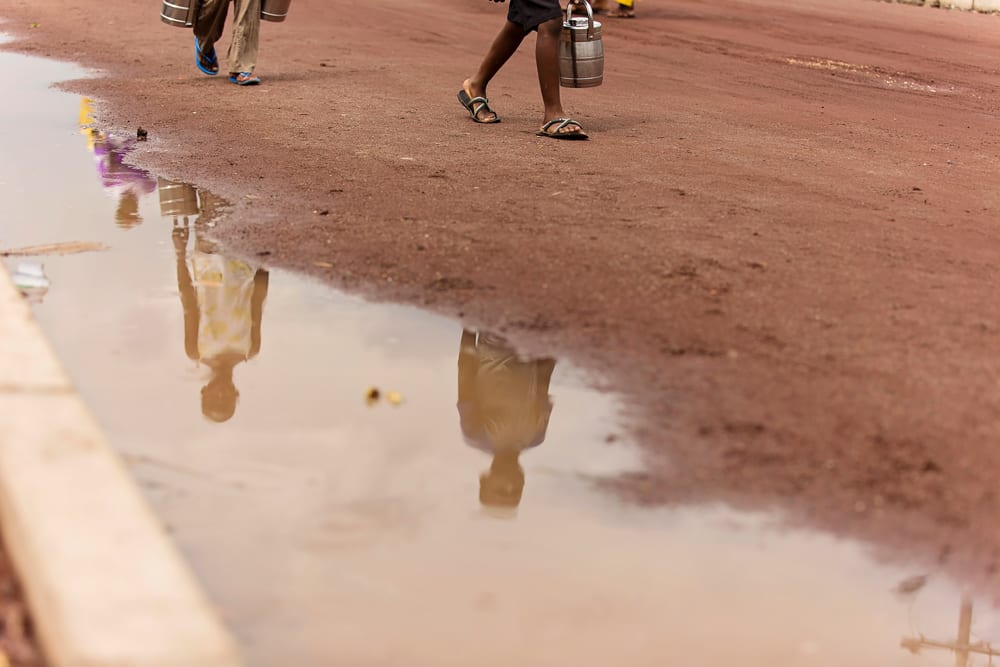
Dec 3-4
When I last wrote, we were feeling pretty downtrodden and disheartened with the way our Rwandan experience was going because of troubles with reliable information and expectations that didn’t match reality. The good news is that we made a good choice (well, we were forced into what would end up being a good choice) in going to Gisenyi.
Gisenyi ended up matching what I pictured Rwanda to be – an eclectic mix of poverty and privilege running side by side along dirt roads lined with fences and bougainvillea vines. The city has three very distinct feels to it: colonial-era lake retreat along the beautifully lanscaped, palm-fringed waterfront boulevard; bustling East African commercial centre verging on mania; and a spooky sense of post-apocalyptic abandonment if you end up walking alone on the dirt roads that we would consider backroads (but actually make up most of the town’s streets).
One of the interesting things about Gisenyi is that it forced me to analyse a few of the opinions that I was forming about Rwanda. The main one being that it has a very hostile feel to it when walking along the streets. It is anything but hostile. However, the majority of locals don’t return your smiles; they’re happy for you to get on with your business because they’re on their way to get on with theirs. That being said, we had plenty of people who wanted to say hello or who smiled back – most notably, a gang of young boys we bumped into twice, one of whom broke into a huge grin and a hilarious knee-knocking dance (think Pee Wee Herman) while holding his hand out to ask for money. If I weren’t so opposed to giving handouts, I would’ve given him something to reward him for his sheer entertainment value. :)
Gisenyi presented the opportunity to start trying out the local buffet lunch offerings – always stewed goat, beans, fries, rice, potato-plaintain stew, and a red, thin-but-tasty sauce that can be poured over everything; always cold, but always cheap (and surprisingly good). Having now tried a variety of other local offerings, I still prefer the goat! We dined at La Corniche one night, and I ordered ugali with beef stew so that Rich could try this East African staple. My meal came as three dishes: a giant ball of ugali (almost the size of two softballs), which is a stretchy steamed dough (think dumpling, but really, definitely, not) made using cassava and maize flour; chopped, steamed (I think? maybe fried?) cassava leaves; and a bowl of beef stew in lots of thick sauce. The waitress brought a pitcher of warm water and a bowl over to the table and poured it over my hands. This meal is eaten without cutlery, so cleanliness is important. I still remember the last time I had ugali: during a month-long trip to Tanzania in 2006, our cooks made it for us one night and served it to us with what I think was a sardine stew (it was almost pitch black during dinner in the rural schoolyard, so we never figured out for sure what it was). I didn’t particularly enjoy that meal, which I blamed on the mystery crunchy bits that I had in almost every bite (which I assume were small fish bones). Turns out that wasn’t the only part of the meal I didn’t like. Ugali is tasteless and nearly textureless – it’s just a smooth, thick mass used to soak up sauce and pick up meat, but it’s pretty difficult for me to stomach. I happily shared my plate with Rich and encouraged him to eat as much as he liked. :) The stew was delicious and even the leaves were tasty. The food was plentiful; I felt bad leaving so much of the ugali and the leaves behind – well, I felt bad about leaving the greens behind. The ugali, not so much….
When we weren’t eating or lounging at the rather grand Discover Rwanda Gisenyi Beach hostel, we were walking the streets to see what was happening. Among our discoveries, I found a dance rehearsal in a schoolyard; Rich found two football games, one being a tournament in front of a rather spectacular backdrop of terrraced hills.
Our rather formidable hostel had completely awful internet access, but did have the most beautiful setting of probably any hostel I’ve stayed in. The building appeared to be a colonial-era mansion that was converted by the charity Women for Women, and had landscaped grounds with footpaths leading to outdoor sitting areas and made awesome use of cream-coloured floor-to-ceiling drapes along most of the walls in the main sitting areas inside to create this wonderfully light space. We occupied what must’ve been the equivalent of the presidential suite: giant bed facing French doors that led out onto a private balcony, which faced the main footpath to the hostel and the main gate, which in turn faced the palm trees on the boulevard and the lakeshore. We took to sleeping with the doors open at night so that we could enjoy the view in the mornings. Given that the room was only $10 more per night than our Kigali room, it made for an enormous step up in quality and setting.
On our second (and final) full day in Gisenyi, the sun FINALLY came out! We enjoyed a walk along the road leading further south down the coast and then in the opposite direction because Rich wanted to see what the Congolese border looked like so that we’d be sure of what we were doing the following day. It got pretty darn hot (we got sunburnt because we weren’t expecting the sun after so many days of distinctly mediocre weather), so Rich decided to go for a swim, while I sat on the coarse sandy beach and took photos. There’s a funny thing happening in Gisenyi: men roam the shore with cameras, taking locals’ photos, which they then print out on the spot from tiny portable printers. It’s pretty cool. It also meant that there was a small gang of men who took a very significant interest in my camera, which, disconcertingly, then drew far more attention to me than I expected (although, given that we were the only two white people in the area, it probably wasn’t the camera that caused the ruckus). The upside to everyone knowing I had a camera was that the guys jumping off the pier then wanted me to take their photo, so I had permission to aim my lens at just about anyone I wanted. :) After jumping into the water feet-first instead of diving, Rich made a friend named Jean-Paul, who seemed to take pity on this foreigner’s ignorance (also known as ‘safety-consciousness’ in our part of the world), and coached him on what to do on his next dive. The two of them jumped from the pier several times while I chatted to Yves, who decided to befriend me because he wasn’t swimming, either.
In the end, Gisenyi was a Rwanda highlight. It presented us with the opportunity we needed to settle into Rwanda and find our feet so that we could understand what we were seeing and how to interact with it. It’s a little unfortunate that it took until (what was meant to be) our final stop for this to happen, but it was rewarding all the same.
Up next: Goma and Gorillas
Grateful for: lakeshore friends; French doors






